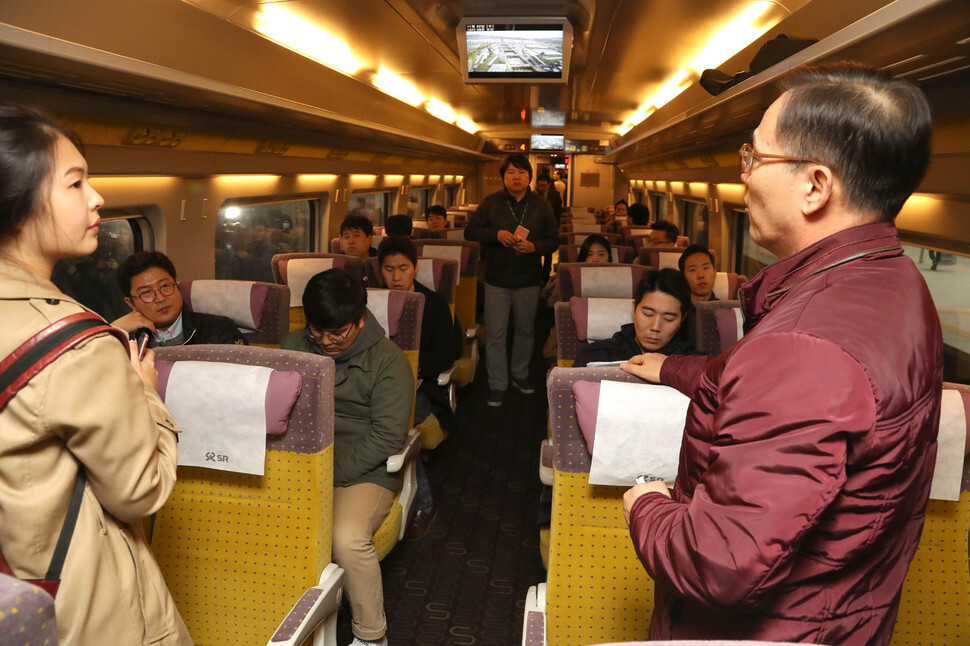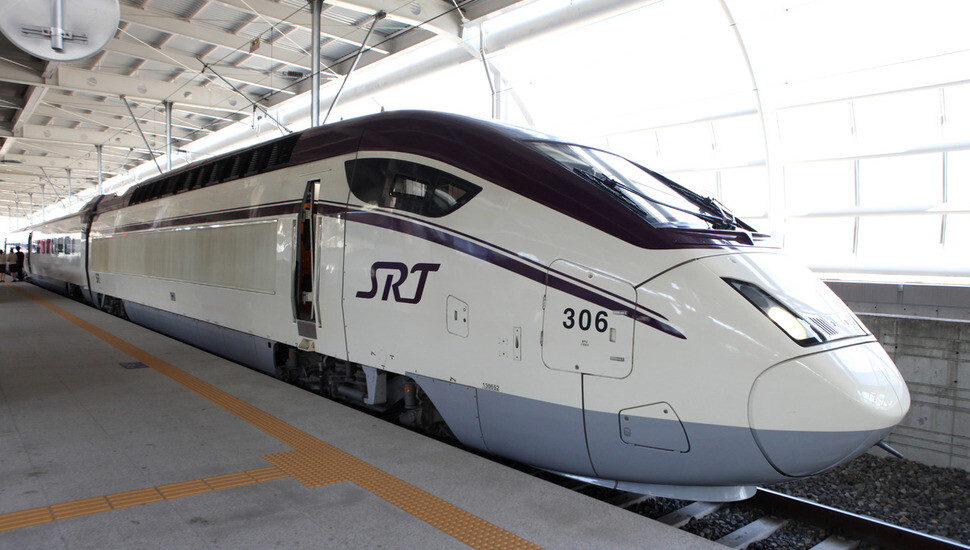hankyoreh
Links to other country sites 다른 나라 사이트 링크
New high-speed train connects Gangnam to South Jeolla Province

Early December will mark the opening of SRT, a new high-speed railroad service departing from Suseo Station in Seoul’s Gangnam district. The service will be operating a Gyeongbu Line between Suseo and Busan and a southwest Honam Line from Suseo to Mokpo in South Jeolla Province. The introduction of the SRT means there are now two high-speed rail option, 12 years after the 2004 opening of the KTX.
The Ministry of Land, Infrastructure and Transport held a trial ride event on Nov. 2 between Suseo and Osong Station in North Chungcheong Province. The SRT’s station of origin at Suseo is linked by underground passageway to the Bundang branch of the Seoul subway system’s Line 3. Passengers leaving a subway train will have less than a five-minute walk to reach the SRT platform. The high-speed train departing from Suseo traveled 56.9 km through a tunnel past Dongtan Station and on to Jije Station. Spending around 20 minutes in the darkness with no scenery visible outside the window, the experience was akin to a high-speed subway ride - something some passengers may find frustrating.

Dongtan Station was newly created for the SRT service launch. As with a subway station, it has screen doors opening on its platform - reportedly a first for any high-speed rail service. The Dongtan Station course is set to be shared in the future by SRT and the GTX express rail service. The GTX, which is set to open in 2021, will operate over a 39.5-km stretch between Samseong and Dongtan.
At Pyeongtaek, Gyeonggi Province the SRT merges with the Gyeongbu Line currently used by the KTX. It is scheduled to make 60 outbound trips a day, including 40 on the Gyeongbu Line and 20 on the Honam line. Thanks to the close distance, riders will be able to reach their destinations seven to eight minutes faster than with the KTX, and at a fare averaging 10% less.
Outwardly, the SRT resembles the KTX. But it also differs slightly in its color scheme and internal facilities. For SRT, a reddish-brown pattern on a white background will be used. One notable feature of the facilities is the placement of plugs at every seat to allow for smartphone charging and laptop use. Passengers will also have easy access to wireless internet and 5.2 to 5.7 cm more legroom than with the KTX. Another feature is a special car (No. 4) offering priority to disabled persons, pregnant women, senior citizens, and other vulnerable members of the population, with headrests made available for riders in the car. The current plan is to make the car available on an honor system, similar to the one currently in effect for priority seats on the subway. Separate men’s and women‘s bathrooms are provided between cars, with nursing facilities made available in some of them.
The SRT’s opening comes after a long and rocky process. It had originally been scheduled to open in late 2015, but was delayed to August 2016 and then again to early December after cracks formed in the tunnel due to “foundation weakness” issues.
By Kim So-youn, staff reporter
Please direct questions or comments to [english@hani.co.kr]

Editorial・opinion
![[Editorial] Penalties for airing allegations against Korea’s first lady endanger free press [Editorial] Penalties for airing allegations against Korea’s first lady endanger free press](https://flexible.img.hani.co.kr/flexible/normal/500/300/imgdb/original/2024/0502/1817146398095106.jpg) [Editorial] Penalties for airing allegations against Korea’s first lady endanger free press
[Editorial] Penalties for airing allegations against Korea’s first lady endanger free press![[Editorial] Yoon must halt procurement of SM-3 interceptor missiles [Editorial] Yoon must halt procurement of SM-3 interceptor missiles](https://flexible.img.hani.co.kr/flexible/normal/500/300/imgdb/child/2024/0501/17145495551605_1717145495195344.jpg) [Editorial] Yoon must halt procurement of SM-3 interceptor missiles
[Editorial] Yoon must halt procurement of SM-3 interceptor missiles- [Guest essay] Maybe Korea’s rapid population decline is an opportunity, not a crisis
- [Column] Can Yoon steer diplomacy with Russia, China back on track?
- [Column] Season 2 of special prosecutor probe may be coming to Korea soon
- [Column] Park Geun-hye déjà vu in Yoon Suk-yeol
- [Editorial] New weight of N. Korea’s nuclear threats makes dialogue all the more urgent
- [Guest essay] The real reason Korea’s new right wants to dub Rhee a founding father
- [Column] ‘Choson’: Is it time we start referring to N. Korea in its own terms?
- [Editorial] Japan’s rewriting of history with Korea has gone too far
Most viewed articles
- 160% of young Koreans see no need to have kids after marriage
- 2Presidential office warns of veto in response to opposition passing special counsel probe act
- 3Months and months of overdue wages are pushing migrant workers in Korea into debt
- 4Hybe-Ador dispute shines light on pervasive issues behind K-pop’s tidy facade
- 5Japan says it’s not pressuring Naver to sell Line, but Korean insiders say otherwise
- 6[Reporter’s notebook] In Min’s world, she’s the artist — and NewJeans is her art
- 7[Editorial] Penalties for airing allegations against Korea’s first lady endanger free press
- 8Inside the law for a special counsel probe over a Korean Marine’s death
- 9OECD upgrades Korea’s growth forecast from 2.2% to 2.6%
- 10[Exclusive] Hanshin University deported 22 Uzbeks in manner that felt like abduction, students say